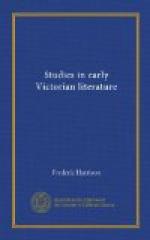Nothing but a few sketches could be compressed into six hours. But it is curious how many things seem omitted in this survey of the heroic. At the age of forty-five Carlyle had not recognised Friedrich at all, for he does not figure in the “Hero as King.” Napoleon takes his place, though Bonaparte was a “hero” only in the bad sense of hero which Carlyle was seeking to explode. It is well that, since he finished the French Revolution, Carlyle seems to have found out that Bonaparte “parted with Reality,” and had become a charlatan, a sham. Still for all that, he remains “our last great man.” Mazzini was present at the delivery of these lectures: and when he had listened to this last, he went up to Carlyle and told him that he had undone his Hero-Worship and had fallen from the truth; and from that hour Mazzini would hold no terms with the gospel of One-Man. To make Hero-Worship close with the installation of Napoleon as “our last great man,” was to expose the inherent weakness of the Sartorian creed—that humanity exists for the sake of its great men. The other strange delusion is the entire omission from the “Hero as Priest” of any Catholic hero. Not only are St. Bernard, and St. Francis, Becket and Lanfranc—all the martyrs and missionaries of Catholicism—consigned to oblivion:—but not a word is said of Alfred, Godfrey, St. Louis, St. Ferdinand, and St. Stephen. In a single volume there must be selection of types. But the whole idea of Hero-Worship was perverted in a plan which had no room for a single Catholic chief or priest.
This perverse exaggeration of Puritan religion, and the still more unjust hatred of Catholic religion, unfortunately runs through all Carlyle’s work, and perhaps nowhere breaks out in so repulsive a form as in the piece called “Jesuitism” (1850), in the Latter-Day Pamphlets (No. VIII.). Discarding the creed, the practice, and the language of Puritanism, Carlyle still retained its narrowness,




